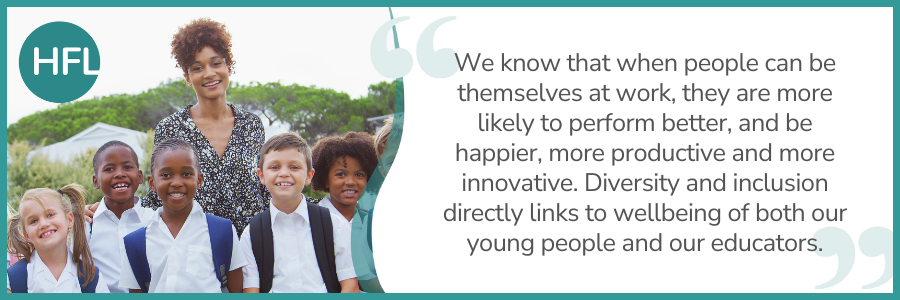
Against a worrying international backdrop, where major firms (including Meta, Amazon, Walmart and McDonald's) are reversing their diversity and inclusion initiatives, the stark underrepresentation of minority ethnic groups in our school workforce is of huge concern.
Year after year, data tells us that people of colour are less likely than their white counterparts to receive or accept an offer for Initial Teacher Training (ITT), and often face negative experiences during training that impact their ability to achieve qualified teacher status (QTS). Retention rates are also lower for teachers of colour, driven by racial discrimination, limited career advancement, and disillusionment with their impact on minority pupils. Despite a small increase in the latest year, the recent ITT census tells us that numbers of entrants to teaching remain well below DfE targets. Within the context of this ongoing recruitment crisis, surely more must be done to increase the number of staff from minority backgrounds entering and succeeding in the school workforce.
Apart from the potential to reduce overall teacher shortages, improving the diversity of school staff is vitally important for a number of reasons:
- You can’t be what you can’t see
- Pupils of colour taught by a same-race teacher have more positive outcomes
- Encountering people from diverse backgrounds enriches our society and helps to counter negative racial stereotypes, providing important recognition for children from minority groups
- We know that when people can be themselves at work, they are more likely to perform better, and be happier, more productive and more innovative. Diversity and inclusion directly links to wellbeing of both our young people and our educators.
Creating an inclusive and anti-racist school culture is essential for improving recruitment, retention and progression among under-represented groups. However, unlike Scotland and Wales, England currently has no national initiatives to address this.
Supported by HFL Education and Herts County Council, many schools and trusts are pioneering this work at a local level, through initiatives like Great Representation and Herts Voices, not to mention our Staff Network and National Race Equity Conference.
We were curious to see what impact this work is having on the ground, and asked some of our brilliant colleagues to share their experiences with us. Some of the recurrent themes from their stories are covered here:
Will I be welcome?
One headteacher, who prefers to remain anonymous, reports that she was slightly hesitant to apply to a village school because of the lack of diversity, but was keen to move and also to take on a headship, which she knew she was ready for.
Before that, I felt trapped and did not have the confidence to look elsewhere as I had no form of encouragement. When I did develop the courage to start looking elsewhere, I was finally given the chance to be Head of faculty as well as an Assistant Headteacher after close to 12 years. I brought the English results to 85% A* - C and 99% A* -C in Literature. Sad though as I am now about to retire. It took this long for me to be recognised as management material. It has been a very lonely and hard road to travel, and I am glad I did not give up.
Many teachers of colour share that they have felt stereotyped and pigeonholed:
Even when I finally did get my job on SLT, the stereotype of being a black teacher that you have the ability somehow, some magic wand, to fix behaviour. And that’s always there, it’s always been there, even going back to my own education. It was assumed that I would be able to fix behaviour even though I’ve never been a behaviour lead, and also that I would have a bond with the black parents, which of course isn’t always the case, but it was always an assumption.
In her Diverse Dreams TED Talk, Hannah Wilson of Diverse Educators describes this as a “talent spotting crisis - we have got hidden figures in every school, aspirant black, Asian, minority ethnicity educators who want to be leaders, who are leaving the education system because their value is not being recognised by the schools they work in”
Isolation:
Particularly in the current climate and seeing my children in school where they are the minority, it’s double edged. There is something I miss about teaching in inner London and the diversity there, but similarly I think it’s good that I’m working in a school where I definitely see the awe and the happiness when black children walk in and see me. It makes a real difference to them.
Being the only person of colour in this position is lonely and isolated and I sometimes feel that way. I come from a different culture, have an African accent (which I am very proud of) and sometimes have a different ‘take’ on things. However, the new project of ‘The Great Representation’ has been very good for me as person. I feel heard. Somebody is interested in what I have to say.
School leader.
So what can we do about it?
As neatly put by Roxy Batliwala, Assistant Headteacher and EDI Lead at Chater Junior School.
Hertfordshire’s proximity to London offers rich diversity and access to individuals from all protected characteristics. HFL provides strong support, particularly around race equity and broader EDI initiatives.
However, there’s room for improvement. To attract diverse talent, especially from London, we need to amplify the work being done in Hertfordshire. The upcoming alpha generation is more socially conscious and will prioritize workplaces with clear commitments to EDI and social justice. Promoting this work prominently to trainees and ECTs is essential.
The next step is to raise awareness. Keeping EDI on the agenda is crucial. Roxy advises “Say yes to EDI-related events. Often, people feel their voice doesn’t matter, but every perspective is valuable. Participation is vital, even if you can’t always give your best self. Just showing up helps to grow and sustain this important work.”
Through the three cohorts of Great Representation, a wide variety of schools have now undertaken supported studies directly concerned with increasing diversity of staff.
Hollybush Primary School’s Hannah Cracknell and Valerie Noon summed up the starting point beautifully:
As we looked at ourselves, it was startlingly apparent that our staff body does not represent our school community. We are an almost completely female staff, with one male teaching assistant and one male site manager. We are almost 100% White. How can our pupils see themselves?
Raj Khindey of Chater Junior School explains that there’s a fine line to walk:
We don't go out there to recruit people of colour, because that would be biased. I don't want to think I got the job because of the colour of my skin. It should be in on my skillset and it goes back to the Equality Act… it is about showing off your school and the community that you serve… hoping that you find the right person who fits your school.
You can't recruit people just because of their ethnicity but at the same time, you do need to support all people to have equal chances to get those jobs and the representation on the school workforce is just not what it needs to be.
Initiatives undertaken by our GR schools so far have included:
- Extensive staff surveys, with some differentiation of questioning for key groups
- A forum for ethnically minoritised staff “to ensure their voices are heard, and to enable the senior leadership team and governing body to respond to any recommendations made”
- Unconscious bias and anti-racism training for leaders and for staff
- Using the anonymised shortlisting facility on the Teach in Herts website
- Rather than anonymising applications, leaders at one school chose instead to ensure where possible that ethnically minoritised applicants were included on shortlists and, when known to the school, supported to gain the required experience for the post and to write strong applications
- Including equal opportunities form as part of the recruitment process
- More explicitly stating our aspiration to be a diverse and inclusive community on our website and in our recruitment literature
- Reviewing the images displayed on the school website
- Include videos of our staff of colour saying why they enjoy working at our school as part of our recruitment package
- Reviewing and adapting job adverts to encourage candidates from diverse backgrounds including a statement in adverts about inclusion
- Directly marketing our vacancies to diverse groups. Reaching out to our school community rather than just posting adverts on recruitment websites
- Reviewing where and how jobs are advertised (for example ethnically minoritised)
- Thinking about how we can inspire young ethnically minoritised pupils from our own school community to become teachers and return to us in due course (eg through ethnically minoritised teacher presentations at our careers fair and by working through the potential obstacles to this aim with our local ITT provider)
- Positively encouraging those of different backgrounds to apply for roles at all levels, including governance
- Encouraging staff to aspire to more senior roles/offering mentoring for promotion to those from a minority group. Being clear about this as an aim in our equalities plan
- Focusing governor recruitment on securing greater representation around the table
- Ensuring more equitable representation on panels during the interview process
The impact of these initiatives has been significant in many cases. Lisa Davies and Ceiri Withers of Harpenden Academy reported that:
We had little idea how important these changes would be. This year we have had applications from teachers and teaching assistants from a range of backgrounds previously unseen. We felt the shortlisted candidates reflected our ethnically minoritised community, and one prospective teacher commented on how she was encouraged by the school’s new strapline ‘You have a place here’. This is a major step forward for us as a school, and we genuinely believe it is because candidates are encouraged to apply – just like the children, they can see that people that look like me are welcome at school. With appointments made, we are potentially starting our next academic year with a staff that truly represents our children, and that is an achievement!
We hope that this insight into the work being done locally will help to inspire you on your own journey. You can read more on The GRID from our Great Representation schools. The NFER document is also a great resource, providing valuable insights into the lived experiences of ethnic minority teachers and identifying systemic barriers they face. By using this report, schools can develop informed strategies to support equitable practices, improve staff diversity, and create a more inclusive environment that benefits both educators and students.
If you would like to find out more, we would love to hear from you. Please join Shammi and the team in 2025 for our scheduled training:
Anti-racism training: How to lead with confidence 2024-2025
Recruiting, retaining and supporting a diverse staff
Or get in touch to find out how we can support you and your school.



